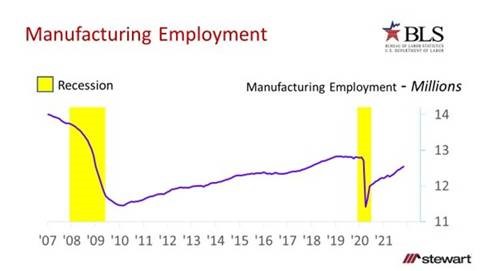After Revving Up in October Job Growth Sputters Like an Engine With Water in the Fuel - November 2021

Job growth, after revving-up in October 2021 and adding 546,000 net new jobs (revised upwards) on a seasonally adjusted basis, sputtered again in November with just 210,000 new jobs (far less than one-half the number expected by economists) as reported by the U.S. Bureau of Labor Statistics (BLS). The unemployment rate, however, did contract from 4.6 percent in October 2021 to 4.2 percent in November and was down from 6.7 percent one year ago. The Federal Reserve considered an unemployment rate from 5.0 percent to 5.5 percent as the tipping point defining full-employment prior to the pandemic. The following table shows monthly change in jobs and the corresponding unemployment rate monthly since January 2020.

Total jobs are shown monthly in the graph commencing in 2007 – prior to the Great Recession. The U.S. has now brought back 82.5 percent of the 22.4 million jobs lost at the onset of the pandemic numerically speaking. Still missing (again numerically speaking) are 3.9 million jobs that existed as of February 2020.

Not all job Sectors were impacted equally by the pandemic nor are they recovering similarly. Monthly job gains as of November 2021 for each of the Super Sectors (as defined by the BLS) are shown in the next table. Also included is the percentage change from the prior month, year-over-year, and prior to the pandemic – February 2020. The hardest hit Sector is no surprise: Leisure & Hospitality, still down 7.9 percent since February 2020 (the month prior to the pandemic). The next most impacted Sector is Mining & Logging (which includes Oil & Gas exploration and production). This helps explain the surge in energy prices as the Sector was impacted even prior to the pandemic by systemic underinvestment given the bias towards renewables.

Employment data are further detailed in the next two tables. The first breaks out the number of jobs by thousands and the second comparative percentages. Financial Activities is still the only Sector that of has more jobs today than in February 2020 – the month prior to the pandemic. Wall Street and employment in the financial space have done well in the pandemic landscape.


Hourly wage rates were up across all Super Sectors on a year-over-year basis as shown in the next table. The greatest gain for both 12- and 24-month periods was Leisure & Hospitality, plus 14.5 percent and 12.3 percent, respectively. Despite the gains, the Sector still remains the lowest paying of all.

Unemployment rates are detailed for Educational Attainment and Demographic Cohorts in the next table. Those with a Bachelor’s Degree had a miniscule unemployment rate of 2.3 percent compared to 5.7 percent among the group not attaining a High School Diploma.

Unemployment rates across Occupations and by Industry & Worker Class are detailed in the next two tables. These data are only reported on an unadjusted basis (not-seasonally adjusted) so can only be compared year-over-year on an apples-to-apples basis.


The hardest-hit Super Sector -- from the number of jobs perspective -- remains Leisure and Hospitality. After losing one-half of all jobs in March and April 2020, the Sector has come back as in the graph. Many believe total recovery in this Sector is still years in the future, however. United Airlines CEO stated that 20 percent of business travel is permanently gone.

The Manufacturing Sector received considerable attention by the press in the October 2021 jobs release report having added 60,000 jobs – double that of the prior month. That was revised down to 48,000, in November by the BLS. Just 31,000 jobs were added in the Sector in November. Manufacturing is struggling more than thought just one month ago.

Jobs are everything to the economy. Period. While the October jobs report was welcome news, November sputtered, disappointing and worrying all.
